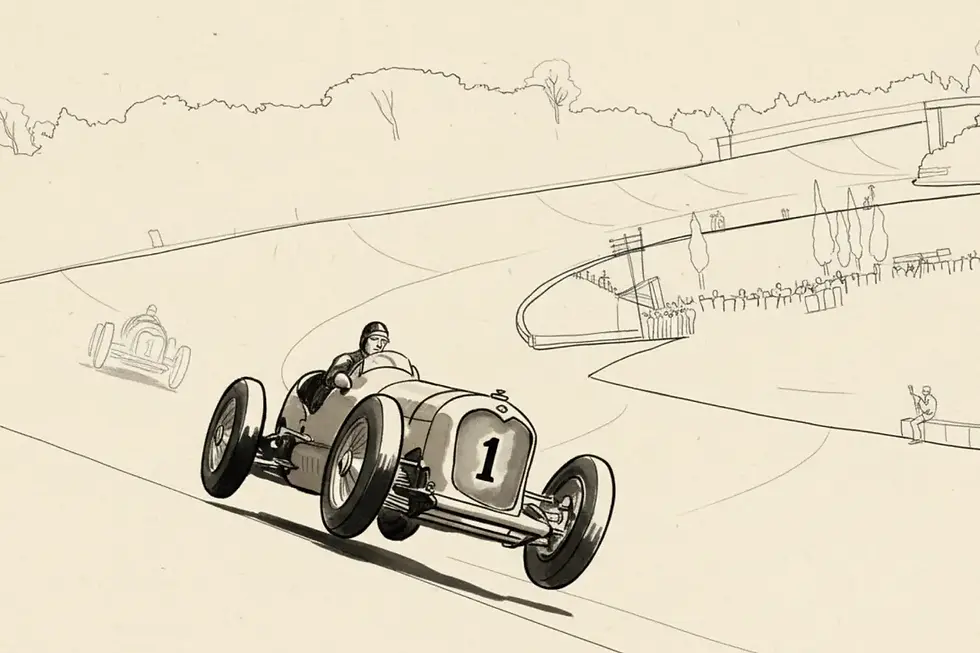Brooklands

Brooklands /brʊk-ləndz/ proper noun
Brooklands was a purpose-built motor racing circuit and aerodrome in Weybridge, Surrey, which operated from 1907 to 1939. This was the cradle of British motorsport and aviation, a vast, banked bowl of concrete built for the singular purpose of going astonishingly fast with a flagrant disregard for personal safety. It was less a racetrack and more a brutalist temple to the gods of speed, a place where gentlemen amateurs in tweed could push primitive machines to their absolute limits. Brooklands was the chaotic, noisy, and deeply dangerous birthplace of a national obsession, a place that combined the glamour of the new motoring age with the grim probability of a colossal accident.
The Full Story of Brooklands
At the dawn of the 20th century, Britain’s motorists were shackled by a blanket 20 mph speed limit. This deeply irritated wealthy landowner Hugh Locke King, who decided that if he couldn't drive fast on the King's highway, he would build his own. He poured his vast personal fortune into a patch of Surrey marshland, nearly bankrupting himself to create a motoring utopia. The result, which opened in 1907, was the world's first purpose-built motor racing circuit.
It was a monster. A 2.75-mile-long, kidney-shaped ring of unpainted concrete, its two signature banked curves rose nearly 30 feet into the air. The banking was a marvel of engineering, calculated to allow cars to corner at immense speeds without the driver even needing to steer. It was a terrifying, bumpy, and utterly unforgiving surface that punished both car and driver.
For the next thirty-two years, Brooklands was the heart of British high-performance engineering. It was a place of endless record-breaking, where giant, aero-engined behemoths like the 24-litre Napier-Railton thundered around the banking at speeds approaching 150 mph. It was the playground of the Bentley Boys, who treated the place as their personal fiefdom, and the backdrop for a vibrant social scene where the thrill of the race was matched by the glamour of the paddock.
Crucially, the infield of the great track was also one of Britain's first aerodromes. It was here that A.V. Roe became the first Briton to get a powered flight off the ground, and legendary manufacturers like Sopwith, Vickers, and Hawker built and tested their aircraft. The history of British aviation is as deeply embedded in the Weybridge soil as the history of its motorsport.
The outbreak of the Second World War in 1939 silenced the roar of the engines. The track was camouflaged with trees to hide the Vickers and Hawker factories that were now building Wellington bombers and Hurricane fighters. It suffered bomb damage during the war, and new access roads were cut through the sacred concrete. After the war, the site was sold, and the cost of repairs was deemed too great. The great track never reopened, passing from a living, breathing cathedral of speed into the realm of legend.
For The Record
Why was the track banked so steeply?
To counteract centrifugal force. The banking was scientifically designed to allow cars to take the corners at over 100 mph without needing to steer or slow down significantly, a radical concept in 1907. On the perfect line, a driver could, in theory, take their hands off the wheel.
Was it dangerous to race on?
Extraordinarily. The concrete surface was notoriously bumpy and unforgiving, bursting tyres and breaking suspensions. There were no safety barriers to speak of, and a crash often meant being launched over the top of the banking. Many drivers and mechanics were killed there over its 32-year history.
What is the Napier-Railton?
It is the quintessential Brooklands car. A massive, brutal machine built by John Cobb purely for record-breaking. It is powered by a 24-litre, 12-cylinder Napier Lion aero engine. It holds the ultimate lap record for the outer circuit at an average of 143.44 mph, set in 1935, and is now the star exhibit at the Brooklands Museum.
Can you still see the track today?
Yes, parts of it. A significant section of the famous Members' banking and the Clubhouse Straight have been preserved and restored as part of the Brooklands Museum. Other parts of the original circuit are now covered by industrial estates and a Mercedes-Benz World complex, but the ghostly presence of the great concrete banks remains.
What happened to the aircraft factories?
The Vickers, and later British Aircraft Corporation, factory at Brooklands remained a vital centre of British aviation for decades, producing famous aircraft like the Viscount, VC10, and vital parts for Concorde before finally closing in the late 1980s.
